Timeline
|
||
1855 |
The front page of The Los Angeles Star, also known as La Estrella, reveals a Montgomery Saloon's advertisement, boasting of billiards tables and bowling alleys.
|
|
1886 |
Charles Kame opens the first Japanese Restaurant in Los Angeles at 340 East First Street (now Little Tokyo). |
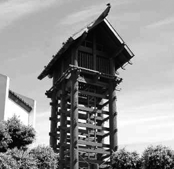 |
1895 |
The American Bowling Congress is organized. It establishes standards on equipment & institutes rules on playing.
|
|
1903 |
Oxnard Sugar Beet Strike: 1500 Japanese and Mexican sugar beet workers strike.
|
|
1907 |
The Gentleman's Agreement between the United States and the Japan Empire called for the halt of Japanese emigration from the empire instead of the United States banning Japanese immigration into the nation.
|
|
1934 |
The first Nisei Week is celebrated in Little Tokyo to keep Japanese traditions alive among the second generation of Japanese living in the United States.
|
|
1940 |
Los Angeles' first freeway, the Pasadena or Arroyo Secco freeway opens. It is also known as the 110 freeway. The freeway connects Pasadena to downtown with its initial maximum speed limit at 45 mph.
|
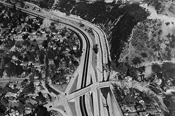 |
1941 |
Japanese torpedo bombers and fighter planes attack Pearl Harbor, killing over 2,400 Americans and devasting the military base. The United States enters World War II.
|
|
1942 |
President Franklin Delano Roosevelt issues Executive Order 9066, interning over 110,000 Japanese and American citizens of Japanese descent into isolated camps throughout the Southwest and parts of the South.
|
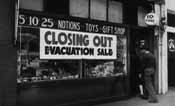 |
1943 |
The Zoot Suit Riots plague Los Angeles' downtown, East side and Chavez Ravine when pumped up servicemen stationed in the Southland seek out local youth to vent hostility. The Los Angeles Times excarbates the events by listing addresses of where the next altercations would take place. The LAPD arrest Zoot Suiters and other Mexican American men and boys caught in the fighting.
|
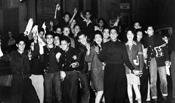 |
1945 |
The United States drops two atomic bombs on the Japanese cities of Hiroshima and Nagasaki. Scientists estimate that over 200,000 residents died as a direct result of the bombing and the after effects of radiation poisoning by 1950. Nearly half of the population of each city died.
|
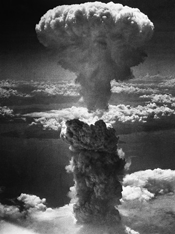 |
1948 |
Perez Vs. Sharpe rules that rules against miscegenation (mixing of the races) through marriage are illegal, allowing Andrea Perez and Sylvester Davis to marry.
|
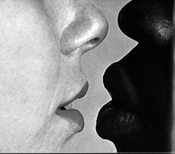 |
1950 |
The national American Bowling Congress (ABC) drops the "white males-only" membership requirement. In 1947 the United Autoworkers threaten to withdraw its sponsorship of bowling leagues & tournaments if the white bowling association did not allow open competition among people of all races. The economic threat of this organization made the American Bowling Congress re-think its racial organization of bowling. This is an example of a local impact on "racial" bowling that affects bowling on a national level.
|
|
1957 |
The Brooklyn Dodgers move to Los Angeles, playing their first games at the Coliseum. |
 |
1957 |
The Holiday Bowl opens.
|
|
1960 |
Judy Seki Sakata Kikuta is the 1st woman west of the Mississippi to bowl a sanctioned 300 game, a member of the Tournament Bowl team, which wins the 1960 National Women's Team Championship, & is named the 1960 Southern California bowler of the year.
|
|
1963 |
The Baldwin Hills flood destroys parts of Cloverdale Avenue in the Crenshaw neighborhood and kills 3 people.
|
|
1963 |
President John F. Kennedy is assassinated in Texas. Five years later, the country would see his brother Robert assassinated as well.
|
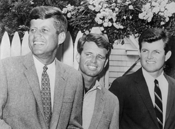 |
1965 |
South Los Angeles is devastated by the Watts Riots. 34 Los Angelenos are killed, some while fleeing from law enforcement. Dr. Martin Luther King visits a church to console and lead victims after the 6 days of terror and loss. Some argue that Watts is still recovering economically from the looting and destruction. Local residents protect the Holiday Bowl during the rioting. |
 |
1968 |
Dr. Martin Luther King Jr is assassinated. The death of the civil rights leader marks a pivot within the movement of radicalization, re-dedication to King's cause, or hopelessness.
|
|
1969 |
President Richard Nixon takes bowling to the executive level by occasionally bowling a few sets to relieve stress.
|
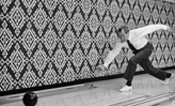 |
1970 - 71 |
Dusty Mizunoue wins back-to-back Western Women's Bowlers Opens in 1970 & 1971 & bowls in the Lady's Professional Bowlers Association. She wins every individual, team championship at the national JACL/JANBA tournaments, & takes part in goodwill tours of Hawai'i (1959) & Japan (1967-68).
|
|
1973 |
Mayor Tom Bradley is elected by Los Angeles voters. He will serve multiple terms and cites bringing the Olympics to Los Angeles in 1984 as his greatest achievement.
|
 |
1975 |
The Vietnam War ends after over a decade of American involvement in both lives and economic support. The war devastates the region and the United States initiates refugee immigration policy.
|
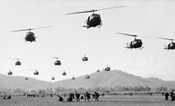 |
1986 |
George Furukawa is mugged outside the Holiday Bowl. He returns to bowl the next day.
|
|
1988 |
Presiden Ronald Reagan issues a formal apology to the victims of Executive Order 9066 and institutes a monetary reparation policy.
|
 |
1992 |
The acquittal of the officers involved in the beating of motorist Rodney King sparks a second riot in South Los Angeles. The video taped beating that required multiple surgeries to repair is described as "disgusting" by President George H. W. Bush, but the Simi Valley jury acquits the officers. A second trial results in the convictions and the acquittal of one officer. Octogenarians stand outside the Holiday Bowl to protect it from looters during the riot.
|
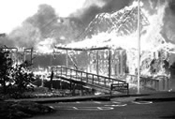 |
1999 |
Lisa Loomer pens Broken Hearts (A BH Mystery), a play that weaves various "BH" and "HB" places in Los Angeles--it uses the Holiday Bowl as a portal to a better time.
|
|
2000 |
The Holiday Bowl closes permanently. Various groups lobby for its saving; however, their efforts are thwarted by local Councilman Nate Holden who calls the empty building "visual blight."
|
|
2003 |
Novelist Nina Revoyr writes Southland, a neo noir told using layers of personal histories in Los Angeles. The Holiday Bowl is initially called 'the Family Bowl' but Revoyr renames it 'Holiday Bowl' in later publications.
|
|
2004 |
The Holiday Bowl History Project begins.
|
|
2005 |
The Holiday Bowl bowling alley is torn down and the restaurant is saved for a Starbuck's coffee shop. |
|